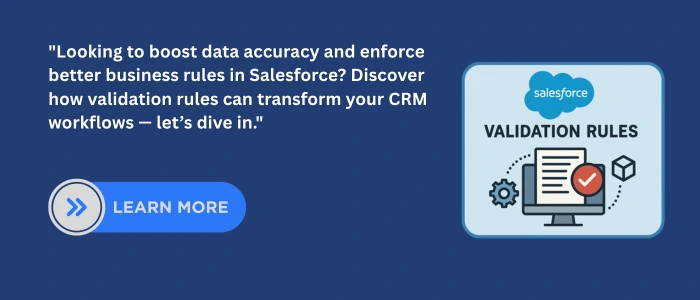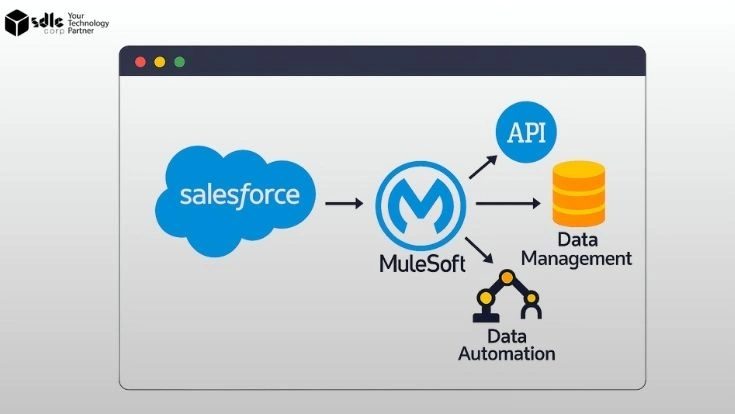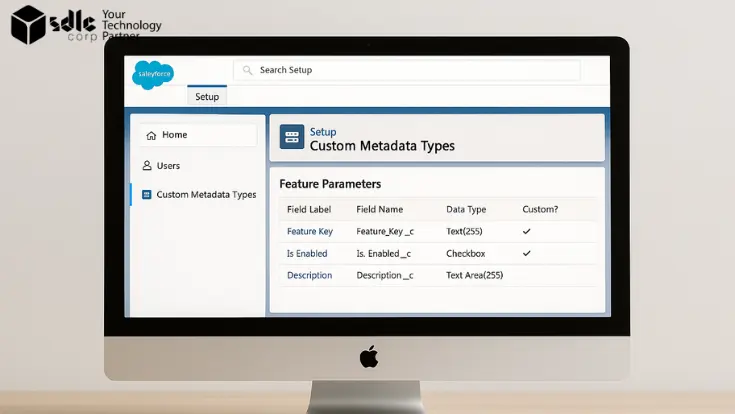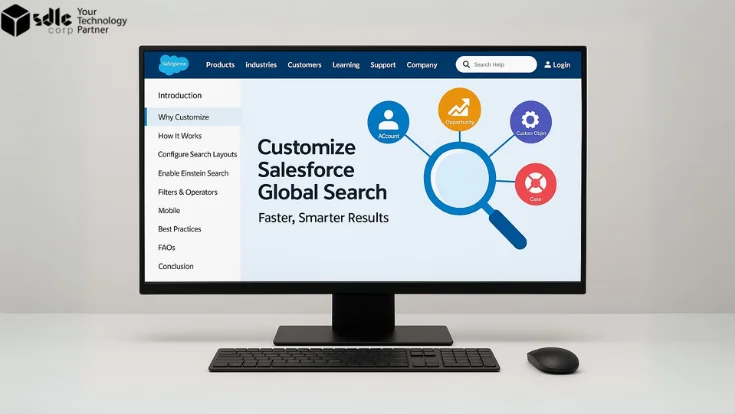Introduction
Salesforce Validation Rules are essential for ensuring data accuracy, compliance, and streamlined business processes within your CRM. They help prevent bad data entry and maintain system integrity across your Salesforce instance. In this blog, you’ll find ready-to-use Salesforce validation rule examples, best practices, and expert insights to get the most out of them.
Whether you’re a Salesforce Admin, Developer, or Consultant, mastering validation rules is key to a healthy CRM. And if you’re looking to strengthen your Salesforce setup further, explore our Salesforce Integration Services and Salesforce Consulting Services for tailored solutions.
1. What Are Salesforce Validation Rules?
Validation Rules in Salesforce are logic-based formulas that validate data entered into fields when a record is created or edited. These rules return TRUE or FALSE based on the logic, and if the result is TRUE, Salesforce displays an error message and prevents the record from being saved.
Validation Rules help enforce business processes, improve data accuracy, and prevent user errors. They are implemented across various Salesforce objects including Leads, Accounts, Opportunities, Cases, and custom objects.
2. Why Use Validation Rules in Salesforce?
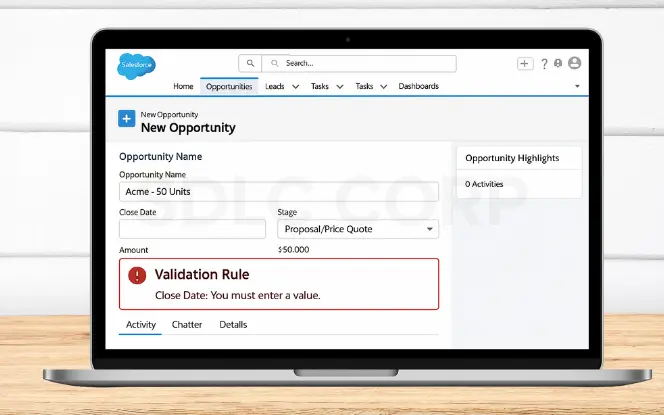
Validation Rules are not just technical tools they serve strategic business purposes. Here’s why they are indispensable:
- Data Quality: Prevents incomplete or incorrect data from being saved.
- Process Compliance: Ensures users follow business processes correctly.
- User Accountability: Forces users to provide necessary information.
- Automation Integrity: Prevents broken workflows or automation issues due to missing data.
- Reporting Accuracy: Clean data leads to more meaningful reports and dashboards.
For example, if your sales team forgets to fill in the “Close Date” field, your forecasting will be skewed. A validation rule prevents this.
3. How to Create a Validation Rule
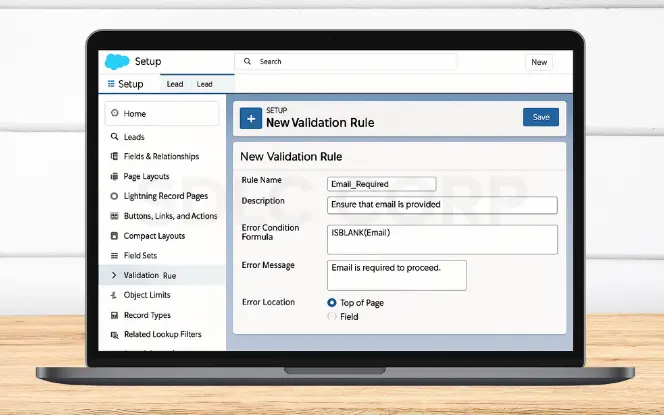
Follow these steps to create a validation rule:
- Navigate to Setup > Object Manager.
- Choose the object you want to apply the rule to (e.g., Lead).
- Click on Validation Rules in the sidebar.
- Click New Rule.
- Enter a Rule Name and Description.
- Write the formula logic (it should return TRUE when you want to show an error).
- Enter the Error Message to be displayed to the user.
- Choose the location for the error message (Top of Page or Field).
- Save the rule and test it in your sandbox.
Example:
ISBLANK(Email)
Error Message: “Email is required to proceed.”
4. 10+ Salesforce Validation Rule Examples
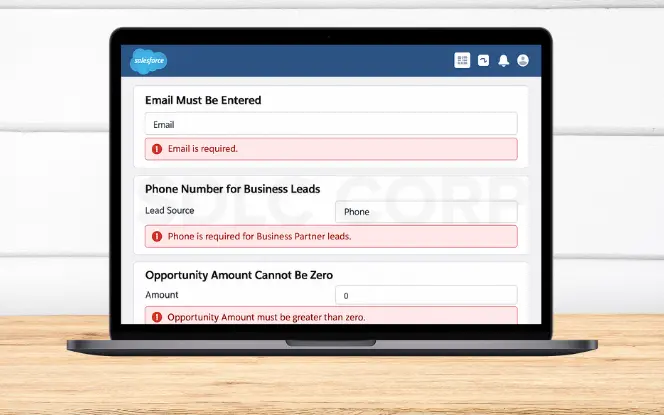
1. Email Must Be Entered
ISBLANK(Email)
Error: “Email is required.”
2. Phone Number for Business Leads
AND ( ISPICKVAL(LeadSource, "Business Partner" ), ISBLANK(Phone))
Error: “Phone is required for Business Partner leads.”
3. Opportunity Amount Cannot Be Zero
Amount <= 0
Error: “Opportunity Amount must be greater than zero.”
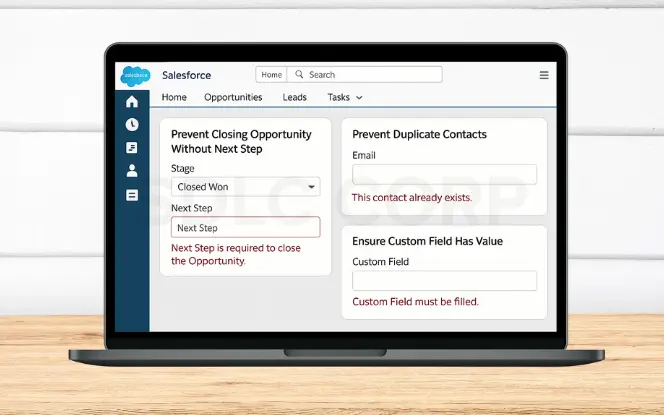
4. Prevent Closing Opportunity Without Next StepAND( ISPICKVAL(StageName, "Closed Won"), ISBLANK(NextStep) )
Error: “Next Step is required to close the Opportunity.”
5. Prevent Duplicate ContactsAND( ISNEW(), NOT(ISBLANK(Email)), Email = PRIORVALUE(Email) )
Error: “This contact already exists.”
6. Ensure Custom Field Has ValueISBLANK(Custom_Field__c)
Error: “Custom Field must be filled.”
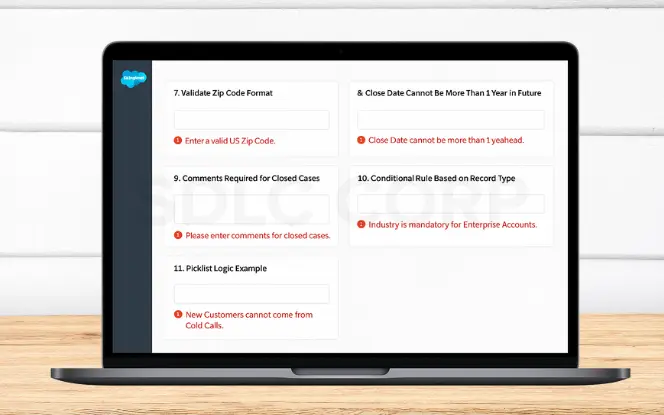
7. Validate Zip Code FormatNOT(REGEX(ShippingPostalCode,
Error: “Enter a valid US Zip Code.”
8. Close Date Cannot Be More Than 1 Year in FutureCloseDate > TODAY() + 365
Error: “Close Date cannot be more than 1 year ahead.”
9. Comments Required for Closed CasesAND( ISPICKVAL(Status, "Closed"), ISBLANK(Comments__c) )
Error: “Please enter comments for closed cases.”
10. Conditional Rule Based on Record TypeAND( $RecordType.Name = "Enterprise Account", ISBLANK(Industry__c) )
Error: “Industry is mandatory for Enterprise Accounts.”
11. Picklist Logic ExampleAND( ISPICKVAL(Type, "New Customer"), ISPICKVAL(LeadSource, "Cold Call") )
Error: “New Customers cannot come from Cold Calls.”
5. Summary of the Above Validation Rules
These 10+ Salesforce validation rule examples cover a wide range of business scenarios that commonly occur in CRM environments. From ensuring required fields like emails and phone numbers are filled out, to enforcing logic based on opportunity stages and record types, these rules help prevent human error and enforce data governance.
Each rule is designed to be user-friendly, efficient, and easily adaptable to your specific Salesforce implementation. Whether you’re working with Leads, Opportunities, Accounts, or custom objects, these examples serve as a strong foundation for building out your validation logic.
Now, let’s explore some more advanced techniques to take your validation rule strategy even further.
6. Advanced Validation Rule Techniques
A. Use Cross-Object References
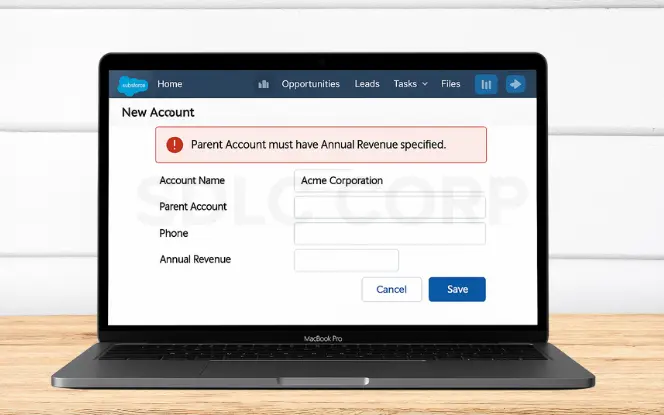
ISBLANK(Account.AnnualRevenue)
Error: “Parent Account must have Annual Revenue specified.”
B. Combine with Custom Permissions
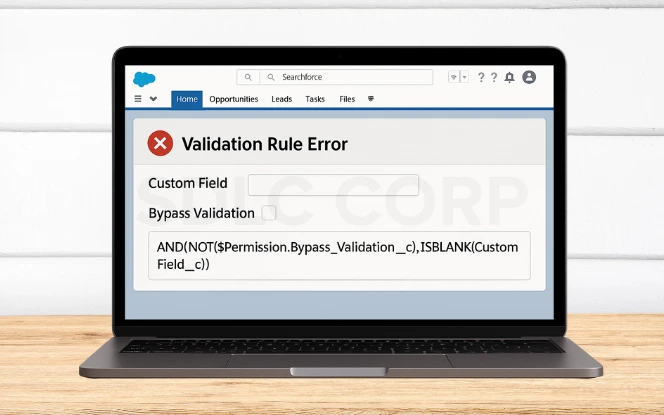
AND( NOT($Permission.Bypass_Validation__c), ISBLANK(Custom_Field__c) )
Use this to allow managers or admins to bypass rules.
C. Evaluate Based on User Profile
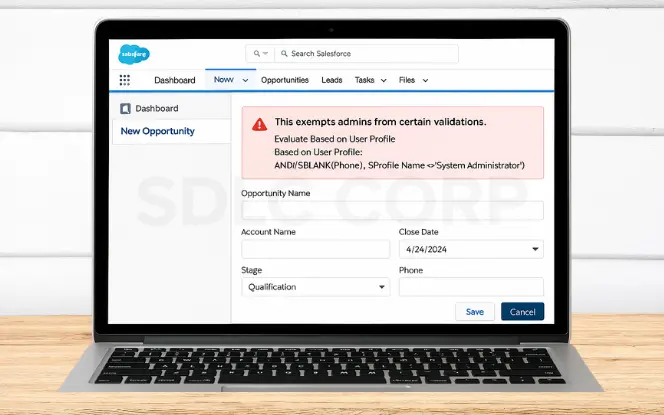
AND( ISBLANK(Phone), $Profile.Name <> "System Administrator" )
This exempts admins from certain validations.
D. Use Helper Formula Fields
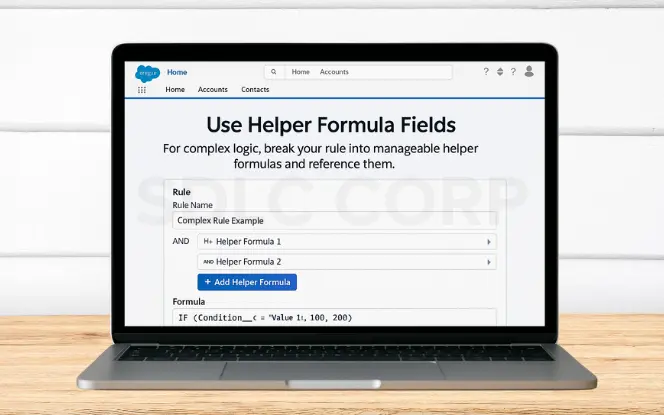
For complex logic, break your rule into manageable helper formulas and reference them. This makes the rule easier to read and maintain.
7. Common Pitfalls and How to Avoid Them
- Too Restrictive Rules: Prevent users from saving valid records.
- Unclear Error Messages: Confuse users.
- Ignoring Testing: Rules that break integrations or automation.
- Redundant Rules: Overlapping conditions clutter the system.
- No Documentation: Makes troubleshooting and handoffs harder.
Pro Tip: Always include a clear description and reason for the rule so your team understands its purpose.
8. Testing & Maintenance
- Use the sandbox to test each rule.
- Simulate real-world use cases.
- Run data loads and automation testing to avoid conflicts.
- Create validation error reports to monitor frequently triggered rules.
- Set a review schedule (quarterly) to update or deactivate outdated rules.
9. Best Practices for Validation Rules
- Use Comments in Formulas: Document logic for future reference.
- Start Simple: Avoid over-complicating initial formulas.
- Use Picklist Functions Properly: Use ISPICKVAL() or TEXT() based on context.
- Test With All Profiles: Ensure it works as intended across roles.
Use Custom Metadata Types: For flexible, admin-configurable logic.
Conclusion
Salesforce Validation Rules are more than just a technical feature they are a powerful tool to enforce data integrity, ensure compliance, and streamline processes across your CRM. By implementing thoughtful, user-friendly validation rules, you can prevent inconsistent data entry, reduce errors, and guide your users to follow best practices every time they interact with a record.
Whether you’re working with Leads, Opportunities, or custom objects, the examples in this guide offer practical, ready-to-use formulas you can customize for your specific business needs. From basic field checks to advanced logic using cross-object references and custom permissions, these rules form a critical layer of control in your Salesforce org.
But don’t stop there review your validation logic regularly, test thoroughly in sandboxes, and keep your rules aligned with evolving processes. This proactive approach will ensure your Salesforce instance remains scalable, reliable, and user-friendly as your organization grows.
Need help implementing Salesforce rules and workflows? Check out our Salesforce Implementation and Support Services to take your CRM to the next level.
Related Blogs You Should Explore:
FAQ'S
What Are Validation Rules In Salesforce?
Validation Rules are logic-based conditions that prevent users from saving a record unless specific criteria are met. They help enforce data standards and ensure business logic is followed in real-time.
Can I Temporarily Disable A Validation Rule?
Yes. You can conditionally bypass a rule by adding logic that checks for a checkbox field, user profile, or custom permission. For example:
formula
CopyEdit
AND(ISBLANK(Phone),
NOT($Permission.Bypass_Validation__c)
)
This method gives admins flexibility without fully deactivating the rule.
Do Validation Rules Apply To Data Loader And API?
Absolutely. Validation rules are enforced across all data entry points including:
- Standard UI (record creation/edit)
- API-based integrations
- Tools like Data Loader, Workbench, and third-party apps
If your rule isn’t working via API, check if conditional logic is skipping it unintentionally.
How Can I Write Better Error Messages?
User-friendly error messages are clear, specific, and helpful. Avoid technical language like “REGEX failed.” Instead, use:
“Please enter a valid email address.”
“Email does not match pattern.”
Focus on guiding users, not confusing them.
Can Flows Use Validation Rules?
Not directly. Salesforce Flows don’t trigger or call validation rules. However, you can:
- Replicate the same logic in Decision nodes
- Use Apex logic or custom screen validation
- Trigger errors through custom screen components
For backend enforcement, validation rules remain the best choice.
Are Validation Rules Retroactive?
No. They only trigger on create or update events. If you want to identify non-compliant historical data:
- Run reports or validation checks manually
- Use Data Quality dashboards
- Create temporary rules with checkboxes to filter invalid records

